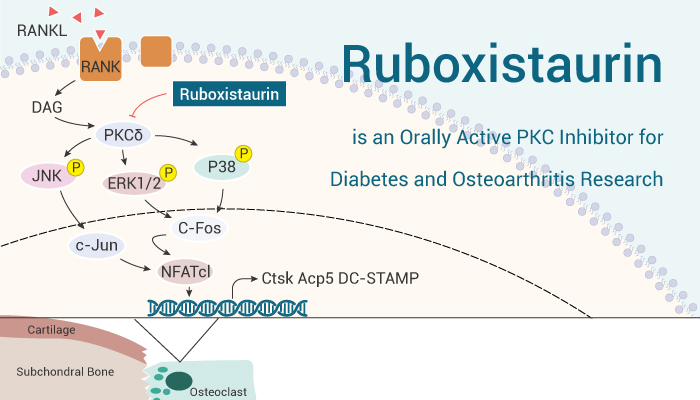PKC (Protein kinase C) is a family of protein kinase enzymes that are involved in controlling the function of otherproteins through the phosphorylation of hydroxyl groups of serine and threonine amino acid residues on these proteins. Hence PKC enzymes play important roles in several signal transduction cascades. In biochemistry, the PKC family consists of fifteen isozymes in humans. Conventional PKCs contain the isoforms α, βI, βII, and γ. Recent reports have strongly enhanced the important role of PKC, especially β isoform, in alterations of retinal blood flow due to diabetes. PKC-β is preferentially activated in the retina, heart, aorta, and renal glomeruli of experimental diabetic animals.

Ruboxistaurin (LY333531) is an orally active and selective PKC beta inhibitor.
Ruboxistaurin selectively inhibits the PKCβ1 and PKCβ2 isoenzymes with respective IC50 values of 4.7 nM and 5.9 nM in vitro. Importantly, Ruboxistaurin has the potential for study of diabetic macular oedema and other diabetic angiopathies, including diabetic retinopathy, diabetic peripheral neuropathy and diabetic nephropathy. For example, in mice, Ruboxistaurin 1 and 10 mg/kg significantly reduces PKC activity in renal glomeruli, and normalised GFR and filtration fraction. In addtion, Ruboxistaurin 10 mg/kg for 8 weeks significantly reduces urinary albumin excretion in diabetic rats. Besides, in diabetic rats, Ruboxistaurin (0.1-10 mg/kg; oral administration; 4 weeks) attenuates the increase of leukocyte entrapment in the retinal microcirculation during the period of early diabetes. Therefore, Ruboxistaurin helps improve retinal blood flow abnormalities in early-stage diabetes models.
In conclusion, Ruboxistaurin is an orally active and selective PKCβ1 and PKCβ2 inhibitor, and has the the potential for study of diabetic macular oedema and other diabetic angiopathies.
References:
[1] A Nonaka, et al. Invest Ophthalmol Vis Sci. 2000 Aug;41(9):2702-6.
[2] Drugs R D. 2007;8(3):193-9.